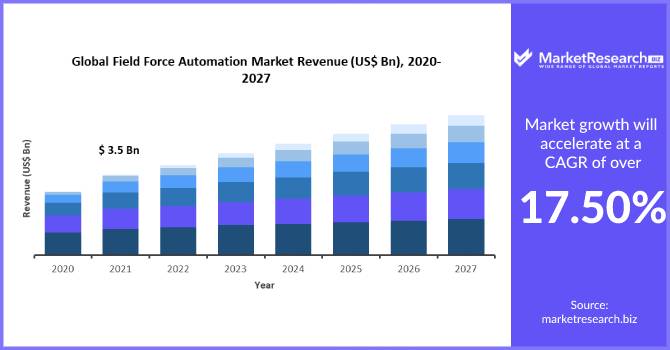
Global Field Force Automation Market Forecast, Trend Analysis And Competition Tracking - Market Insights: 2015 – 2031
-
29098
-
May 2023
-
178190178190
-
-
This report was compiled by Kalyani Khudsange Kalyani Khudsange is a Research Analyst at Prudour Pvt. Ltd. with 2.5 years of experience in market research and a strong technical background in Chemical Engineering and manufacturing. Correspondence Sr. Research Analyst Linkedin | Detailed Market research Methodology Our methodology involves a mix of primary research, including interviews with leading mental health experts, and secondary research from reputable medical journals and databases. View Detailed Methodology Page
-
Quick Navigation
- Field Force Automation Market Overview:
- What is FFA?
- What are the potential benefits of FFA for business?
- Why do businesses use FFA?
- What is a typical workflow sequence within a typical FFA implementation?
- Benefits and Challenges of Field Force Automation
- Upfront Investments for Ensuring the Security of Mobile Devices
- Competitive Landscape
- Key Segments Covered
Field Force Automation Market Overview:
The Field Force Automation Market was valued at $21.40 million in 2021 & is projected to reach $54.52 million by 2027. It is expected to grow at a 12.4% CAGR between 2021 and 2027.
Field force automation is needed to improve productivity. It helps reduce the time it takes to process transactions, enabling businesses to keep up with the increased demand for services.
Automation also enables people to grow their businesses instead of spending time on mundane tasks requiring human intervention.
Implementing field force automation will allow organizations to maintain a competitive edge in the marketplace by providing customers with more offerings and greater convenience without sacrificing quality.
Field force automation can help improve productivity by reducing the time it takes to process orders, which also helps increase the efficiency and productivity of a company.
It is essential for people in charge of distribution and supply chains to stay on top of this technology as it continues to advance.

Field force automation is a software system that is designed to automate sales and customer service operations. A field force automation system automates tracking sales orders, managing inventory, and delivering products.
With a field force automation system, companies can reduce the time to process orders by automatically updating inventory levels with the most recent information from their suppliers.
In addition, because all data is stored in one place, employees can access customer information from any computer in the organization from any location.
The field force automation system is a computerized system for automating sales tasks. Typical tasks include calculating the pricing matrix, comparing existing products to new ones, and other administrative duties. This paper is about field force automation.
Field force automation, or FFA, is about decreasing the workforce needed at customer sites. This article will include the following topics:
-
What is FFA?
Field force automation is the process of automating document handling. Documents are scanned and put into a database or spreadsheet in this process. From here, these documents can be searched by keywords for easier retrieval. Documents can also be organized in folders to help with retrieval and organizing. The scanning of these documents can take a considerable amount of time, depending on the size and density of the document.
-
What are the potential benefits of FFA for business?
The article will discuss how companies use Field Force Automation (FFA) to increase productivity, decrease costs, and create better customer service. FFA is the technology that allows managers to track their field workers in real-time, improving the overall work process. It also helps keep employees accountable for their actions by assigning tasks or projects. This can be especially beneficial for industries with a large number of employees who need several supervisors.
-
Why do businesses use FFA?
There are many reasons that businesses use field force automation. First, there are cost savings. Businesses that outsource to providers of FFA can save a lot on payroll costs for scheduling and dispatching. This accessibility also means that a business can have a broader reach for making sales. Using FFA can also help with employee retention rates because it is an easy system to use – meaning employees won't need as much training time if they want to switch jobs.
-
What is a typical workflow sequence within a typical FFA implementation?
A typical workflow sequence for a typical FFA implementation starts with the first and foremost task: defining and designing an appropriate FFA. This is done by assigning the input parameters and constraints to different element types representing forces, forces' directions, or their geometrical configurations.
Benefits and Challenges of Field Force Automation
Field force automation is the use of software to get work done remotely. It enables businesses to improve productivity, offer greater customer service, and reduce costs.
The benefits of field force automation are seen in increased productivity, greater customer service, and long-term savings for your business. Here are five ways that it can help you save money.
In recent years, many companies have been finding ways to automate tasks their employees do. One such task is data collection.
To manage a field force, companies need to hire many employees and spend a lot of time training them. With the help of automation, this process can be done much more efficiently and without a large number of employees.
Companies have found ways to automate tasks that their employees used to do in the past. One recent example of this is field force automation.
Field force automation uses sensors and signposts placed strategically throughout a warehouse or factory to track where employees are located, what products they're handling, and even how fast they're moving.
This technology can lead to more efficient workflows, less clutter in warehouses, and reduced employee injuries.
Upfront Investments for Ensuring the Security of Mobile Devices
Mobile devices such as smartphones and tablets are responsible for the increase in technology use, but they're also responsible for an increased vulnerability to potential threats.
Little has been done to improve the security of these devices, which leaves them open to cyber-attacks and malicious software. To ensure your mobile device is secure and safe from all threats, invest in protective measures like antivirus and encryption software.
Mobile devices are used for nearly every aspect of our lives - from business transactions to accessing sensitive data. As people have become more reliant on their mobile phones, they have also become more vulnerable to security risks.
With the rise in cyber-attacks, it is now more important than ever to take precautionary measures before opening up personal information or finances. These precautions include securing all apps with a password, downloading only trusted apps, and utilizing encryption software.
Competitive Landscape
The field force automation market landscape appears highly consolidated, with a significant chunk being dominated by US players.
- ServiceMax
- Microsoft
- SAP
- Oracle
- Trimble
- ClickSoftware
- Salesforce
- Astea
- FieldEZ
- Accruent
- AcumaticaFolio3
- LeadSquared
- Kloudq
- Appobile Labs
- Mize
- Nimap Infotech
- Channel play
- Other Players
Key Segments Covered
Field force automation Market, By Component
- Solution
- Services
Field force automation Market, By Organization Size
- SMEs
- Large Enterprises
Field force automation Market, By Deployment Mode
- On-Premise
- Cloud
Field force automation Market, By Industry Vertical
- BFSI
- Government & Defense
- IT & Telecommunication
- Healthcare & Life Sciences
- Retail
- Manufacturing
- Education
- Other Industry Verticals
Attribute Report Details Market Size Ask For Market Size Growth Rate Ask For Growth Rate Key Companies Ask For Companies Report Coverage Revenue analysis, Competitive landscape, Key company analysis, Market Trends, Key segments, Distribution Channel, Market Dynamics, COVID-19 Impact Analysis and more… Historical Data Period 2015-2020 Base Year 2022 Forecast Period 2022-2031 Region Scope North America, Europe, Asia-Pacific, South America, Middle East & Africa Country Scope United States, Canada and Mexico, Germany, France, UK, Russia and Italy, China, Japan, Korea, India and Southeast Asia, Brazil, Argentina, Colombia etc.Saudi Arabia, UAE, Egypt, Nigeria and South Africa Revenue in US$ Mn -
-
- ServiceMax
- Microsoft
- SAP
- Oracle
- Trimble
- ClickSoftware
- Salesforce
- Astea
- FieldEZ
- Accruent
- AcumaticaFolio3
- LeadSquared
- Kloudq
- Appobile Labs
- Mize
- Nimap Infotech
- Channelplay
- Other Players




